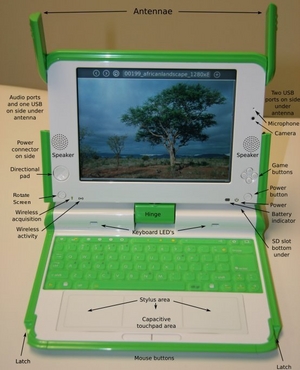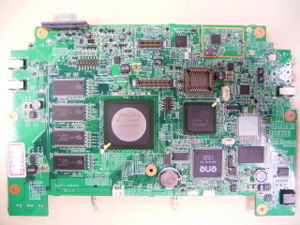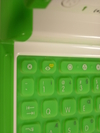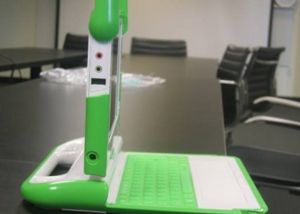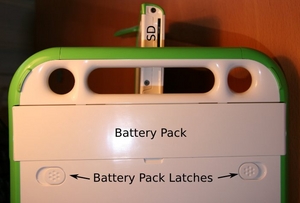Hardware specification/lang-de: Difference between revisions
m (corrected some typing errors) |
|||
| Line 75: | Line 75: | ||
* Stromversorgung: zweipoliger Gleichstromeingang (10 bis 20 V). Stromeingang zwischen -40 to 39 V abgesichert, darüber Schutz durch Einwegsicherung. |
* Stromversorgung: zweipoliger Gleichstromeingang (10 bis 20 V). Stromeingang zwischen -40 to 39 V abgesichert, darüber Schutz durch Einwegsicherung. |
||
* Ausgang: standard 3.5mm dreipoliger stereo Klinkenstecker |
* Ausgang: standard 3.5mm dreipoliger stereo Klinkenstecker |
||
* Mikrofon: |
* Mikrofon: standard 3.5mm zweipoliger mono Klinkenstecker; verfügbare Aufnahmearten: |
||
** Sensor, Gleichstrom mit 2.5 V (3K Ohm impledance) Vorspannung |
** Sensor, Gleichstrom mit 2.5 V (3K Ohm impledance) Vorspannung |
||
** Sensor, Gleichstrom ohne Vorspannung (0 -- 3 V) |
** Sensor, Gleichstrom ohne Vorspannung (0 -- 3 V) |
||
| Line 113: | Line 113: | ||
{{anchor|Laptop Development Schedule}} |
{{anchor|Laptop Development Schedule}} |
||
==Laptop Development Schedule== |
==Laptop Development Schedule== |
||
Revision as of 07:30, 13 November 2008
| Übersetzung von Hardware specification | Original |
| deutsch | english | español | français | italian | 日本語 | 한글 | português | русский indonesia +/- | Änderungen |
- This is an on-going translation
Hinweis!
Diese Seite stellt keine offizielle Seite von "One Laptop per Child" dar. Die Übersetzung erfolgte von der englischen Originalseite und ist durch Zusammenarbeit vieler Wiki-User entstanden.
Hardware
Der XO-Laptop bildet den Mittelpunkt von One Laptop Per Child. Nach zwei Jahren der Entwicklung, tausenden an Entwickler verteilten und in Schulen teilnehmender Länder erprobten Beta (B2) Geräten nähert sich der Laptop der Serienreife. Einige geringfügige Änderungen wurden erst kürzlich durchgeführt, um den Rechner auf dem aktuellsten technischen Stand zu halten.
Spezifikationen
- Grafikkarte: Integriert im Geode Prozessor; unified memory architecture
Abmessungen:
- Größe: 242mm × 228mm × 30mm (ungefähre Angaben, geplant)
- Gewicht: geringer als 1,5 kg (geplant)
- Gestaltung: Notebook mit verdrehbarem Display; schmutz- und nässebestädiges Gehäuse
Elektronische Kerndaten:
- CPU: AMD Geode LX-700@0.8W (datasheet)
- CPU Geschwindigkeit: 433 Mhz
- Kompatibilität: Athlon instruction set (integrierte MMX- und 3DNow! Enhanced- Technologie) mit zusätzlichen Geode-spezifischen Eigenschaften
- North Bridge: PCI- und Speicherinterface integriert im Prozessor
- Grafikkontroller: Integriert im Prozessor
- South Bridge: AMD CS5536 (datasheet)
- DRAM memory: 256 MB dynamic RAM
- Datenübertragungsrate: Dual – DDR333 – 166 Mhz
- BIOS: 1024 KB SPI-interface flash ROM; LinuxBIOS open-source BIOS; Open Firmware bootloader
- Massenspeicher: 1024 MB SLC NAND flash, high speed flash controller
- Laufwerke: keine optischen Laufwerke
- Embedded Controller: ENE KB3700: File:KB3700-ds-01.pdf
Bildschirm:
- LCD: 7.5” Dual-mode TFT display
- sichtbares Bild: 152.4 mm × 114.3 mm
- Bildgröße: 1200 (H) × 900 (V) Auflösung (200 dpi)
- Mono display: High-resolution, reflective monochrome mode
- Color display: 800 (H) x 600 (V) oder höher Transmissive Color Mode
- Stromverbrauch: 0.1 Watt bei ausgeschalteter Hintergrundbeleutung; 0.2-1.0 Watt mit Hintergrundbeleuchtung
- Der DCON - Display Controller chip mit Speicher, der es erlaubt bei schlafendem Prozessor eingeschaltet zu bleiben.
Der Bildschirm und dieser Chip sind die Grundlage unserer extrem wenig Strom verbrauchenden Architektur. Der Computer ist verwendbar und mit dem Netzwerk verbunden, während der Prozessor und die größten Teile des Motherboards ausgeschaltet sind. Siehe dazu das Foto des Displays (es sieht tatsächlich besser aus; Displays zu photographieren ist erstaunlich schwierig)
- Bemerkung: Die Webbrowser-Fotos werden momentan vergrößert um ungefähr der Dimension des Browserfenster zu entsprechen [800x600].
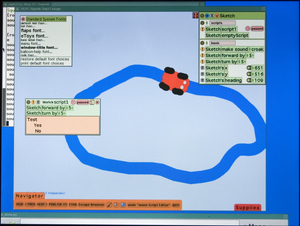
Integrierte Peripheriegeräte:
- Tastatur: über 70 Tasten, 1.2mm Anschlag; gedichtet Gummimembran-Tasteneinheit
- Keyboard Layouts
- Layout Abbildungen (für B3): US International, Thai, Arabic, Spanish, Portuguese, Nigeria, Urdu, French
- Cursorkontrolltasten: Fünf-Tasten Cursor-Control Pad (vier Richtungstasten und Enter)
- Touchpad: ALPS Electric dual kapazitiv/resistiv Touchpad; unterstützt Schrifteingabe
- Audio: Analog Devices AD1888, AC97-kompatibler Audiocodec; stereo mit integrierten dual Lautsprechern; mono mit integriertem Mikrofon das Analog Devices SSM2302 zur Verstärkung benutzt
- Wireless: Marvell Libertas 88W8388+88W8015, 802.11b/g kompatibel; doppelt einstellbar, drehbare, koaxiale Antennen; unterstützt Diversity Reception
- Statusanzeigen: Stromversorgung, Batterie, WiFi; geschlossen und geöffnet sichtbar
- Videokamera: 640x480 Auflösung, 30FPS
- Unabhängig von der Softwareanzeige des Mikrofon- oder Kameraaufzeichnungsstatus
Externe Anschlüsse:
- Stromversorgung: zweipoliger Gleichstromeingang (10 bis 20 V). Stromeingang zwischen -40 to 39 V abgesichert, darüber Schutz durch Einwegsicherung.
- Ausgang: standard 3.5mm dreipoliger stereo Klinkenstecker
- Mikrofon: standard 3.5mm zweipoliger mono Klinkenstecker; verfügbare Aufnahmearten:
- Sensor, Gleichstrom mit 2.5 V (3K Ohm impledance) Vorspannung
- Sensor, Gleichstrom ohne Vorspannung (0 -- 3 V)
- externes Mikrofon, Wechselstrom mit Vorspannung
- Erweiterung: 3 Type-A USB-2.0 Buchsen; MMC/SD Card slot
- Maximale Stromstärke: 1 A (insgesamt)
Batterie:
- vollständig gekapseltes hartes Gehäuse, abnehmbar
- Pack: 4 Zellen, 6V
- Chemische Typen:
- NiMH, Kapazität 16.5 Wh
- LiFeP, 22 Wh
- Im Akkupack integrierte Elektronik ermöglicht:
- Identifikation
- Lade- und Kapazitätsanzeige
- Temperatur- und Überstromsensoren mit Sicherheitsabschaltung
- Lebensdauer: mindestens 2,000 Ladezyklen
- Power Management
BIOS/loader:
- Open Firmware wird, inklusive Hardwareinitialisierung und Schnellstart, als Firmware eingestezt.
Betriebsumgebung:
- Temperatur: über die üblichen Laptopvoraussetzungen hinausgehend; genau Werte wurden nicht festgestezt
- Feuchtigkeit: siehe Temperatur. Im geschlossenen Zustand sollte ausreichende Resisdenz gegenüber Regen und Staub gewährleistet sein.
- Meereshöhe: -15m bis 3048m (14.7 bis 10.1 psia) (im Betrieb), -15m bis 12192m (14.7 bis 4.4 psia) (ausgeschaltet)
- Schlagschutz: 125g, 2ms, Halbsinus (im Betrieb) 200g, 2ms, Halbsinus (ausgeschaltet)
- Erschütterung: 0.75g zero-to-peak, 10Hz to 500Hz, 0.25 oct/min sweep rate (im Betrieb); 1.5g zero-to-peak, 10Hz to 500Hz, 0.5 oct/min sweep rate (ausgeschalten)
- 2mm Plastikwände (1.3mm ist der Standard für die meisten Systeme).
Regulative Richlinien:
- Die üblichen US und EU EMI/EMC Anforderungen werden eingehlaten.
- Der Laptop und sämtliche von OLPC unterstütztes Zubehör werden gemäß den Normen der UL und RoHS entwickelt.
Laptop Development Schedule
The XO laptop hardware development schedule has two more test unit builds (Beta Test 3 and Beta Test 4), before a final test build (C Test 1) on the final production line and mass production. The Beta Test 3 build scheduled for early May will be the first one providing the processor and memory capabilities of the production version.
Pre-production Test Systems (CTest-1, or C1)
This build is a very small number (200 or so) of laptops produced as a test of the manufacturing process on the main production line, and should happen in early fall. A C1 laptop is hopefully identical to a production unit in all aspects...
Beta Test 4 Systems (BTest-4, or B4)
This build, scheduled for the middle of the summer, is the final chance to fix hardware and mechanical problems that were detected in the Beta Test 3 build of the XO. Only a small number (200 or so) of these will be built for testing, as the injection molds for the plastic case have to be taken offline and duplicated to prepare for mass production (the Beta Test mold set will be retired after duplication).
No new features will be added to the laptop in this build. This build is planned merely to test solutions to problems detected in the BTest-3 laptops.
Beta Test 3 Systems (BTest-3, or B3)
This build, scheduled for May, is the first to use an updated design for the laptop. Noticeable improvements over BTest-2 include:
- A faster, lower power processor: the Geode LX-700
- 128 KB of L1 Cache, 128 KB of L2 Cache (vs. 32 KB of L1 cache)
- Faster processor and memory clock (433/333 vs. 366/266)
- 1.5 W typ. vs. 3 W typ.
- Much better graphics processor, including support for rotated blits and depth conversion
- More memory: 256 MB of SDRAM (vs. 128 MB)
- A new hinge design allows greater tilt of the screen
- An improved case design (addressing strength and water resistance)
A very small number of BTest-3 units (around a hundred) will be built, all destined for hardware and low level software development.
Beta Test 2 Systems (BTest-2, or B2)
Approximately 2500 systems were built by Quanta and are being distributed. These are fully functional machines with CaFE asic's, and reflect some, but not all of the learning and improvements from testing of BTest-1. Much more information about the BTest-2 systems can be found in the BTest-2 Release Notes. Some of the details of the hardware design are to support the OLPC Human Interface Guidelines.
BTest-2 systems are almost identical visually with BTest-1. BTest-3 will have more substantial physical differences. An easy way to tell the difference between BTest-1 and BTest-2 is that BTest-1 keyboards have white lettering, and BTest-2 has black lettering.
Beta Test 1 Systems (BTest-1)
Approximately 875 systems were built by Quanta and were distributed. These are fully functional machines, but built before the rigorous testing that will now take place. Much more information about the BTest-1 systems can be found in the BTest-1 Release Notes.
Pre-BTest boards
A small number of pre-BTest boards were built in preparation for building complete BTest systems. Developer information about B-test boards are here.
Alpha Test Prototype Electronics
Power up of the first OLPC electronics prototype boards occurred April 15, 2006. Power and ground testing continued over the weekend, and formal debug and BIOS bring up started Monday, April 17, 2006 at Quanta Computer's labs in Taipei, Taiwan. By Wednesday, April 19, Linux was booting on the first generation prototypes.
Photographs:
- Component side OLPC circuit board
- Back side of the OLPC circuit board
- Picture of Linux running with circuit board in the lab
- Picture of the screen of Linux running on the OLPC circuit board; fittingly, it shows a Chinese desktop
See also
Formerly part of this page:
School Server Hardware
While the laptop is rightfully at the center of OLPC, a valuable peripheral is the school server. OLPC will be building and distributing school servers along with the laptops, to extend the storage and computation provided by each laptop, as well as providing a local library and a mesh portal to the Internet.
Unlike the laptop, the school server is more of a collection of services than a hardware platform. In a manner identical to the laptop, OLPC will collaborate with manufacturing partners to provide a cost-efficient hardware platform for running the recommended software. Unlike the laptop, the manufacturing collaboration will not be exclusive. Individual countries will be free (even encouraged) to design and manufacture their own school servers running derivatives of the OLPC school server software.
XS
This will be the school server built for OLPC by Quanta. It is still in the very early stages of design, but should reach early production volumes in late fall. See the specification.
XSX
This is a prototype school server, built for early school trials in country. It will be integrated from off-the-shelf components, and will be overpowered compared to a production school server in order to simplify early demands for system software. See the specification and the implementation.
